This post may contain affiliate links. Please read our disclosure policy.
Sicilian Eggplant Caponata Recipe (Easy)– Bursting with bold flavors, delicious vegetables, and aromas that define Sicilian cuisine, this beloved Italian dish is wonderful for any occasion.
Serve on crostini, crusty bread with pasta, grilled meats, or a topping for bruschetta.
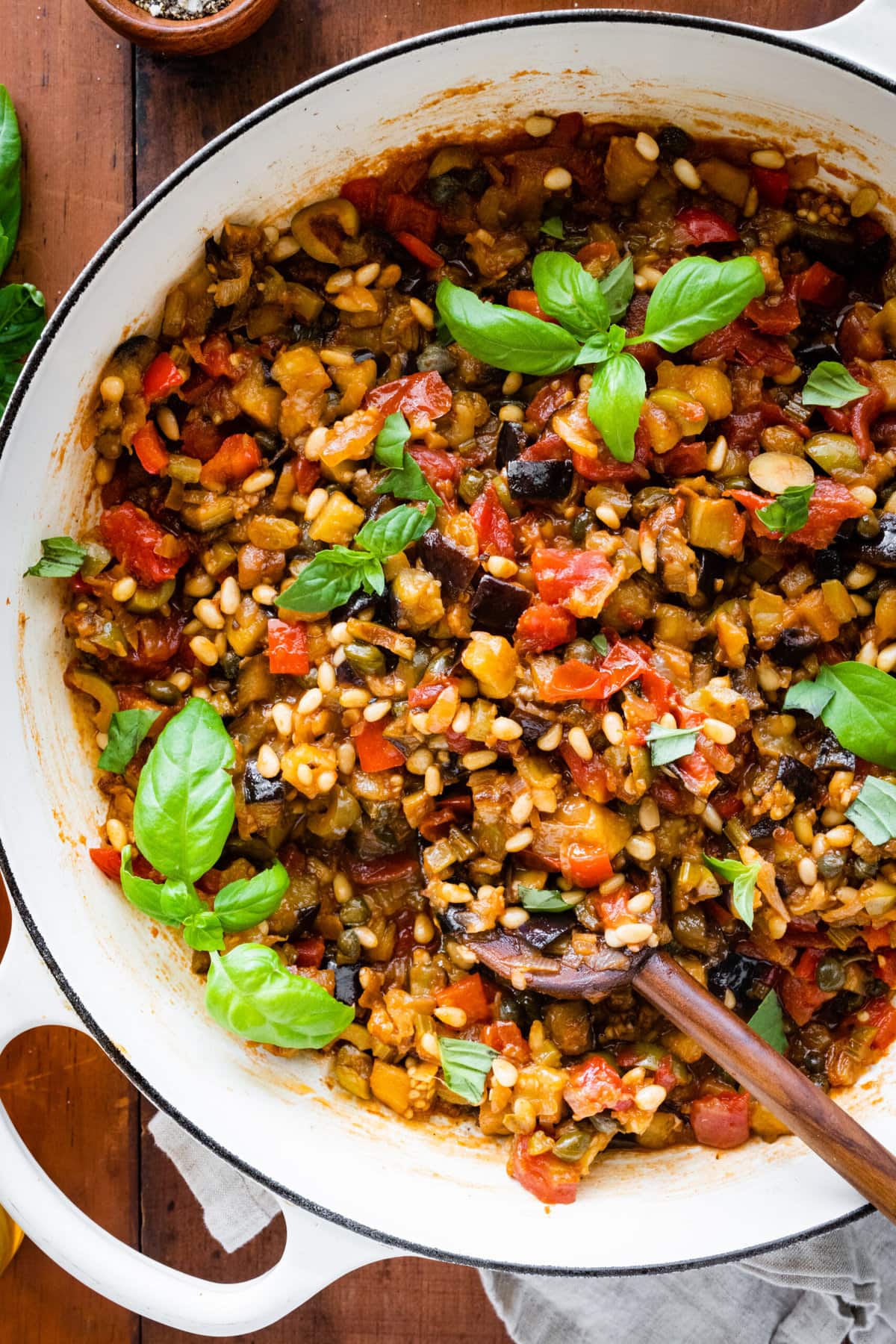
Best Eggplant Caponata
This Sicilian Eggplant Caponata recipe is inspired by my Sicilian friend, Lili, who also gave me her recipe for Authentic Sicilian Cannoli. She is the best Sicilian cook I know, and this Sicilian specialty is authentic and exceptional! This easy recipe is even better the next day, so it’s a great make-ahead dish.
You will also like my Roasted Eggplant, Eggplant Parmigiana Recipe, and Sauteed Eggplant and Tomatoes recipes.
Table of Contents
Simple Ingredients
Fresh and simple ingredients make this authentic caponata the next star at your dinner table. It’s a great recipe for fresh summer produce.
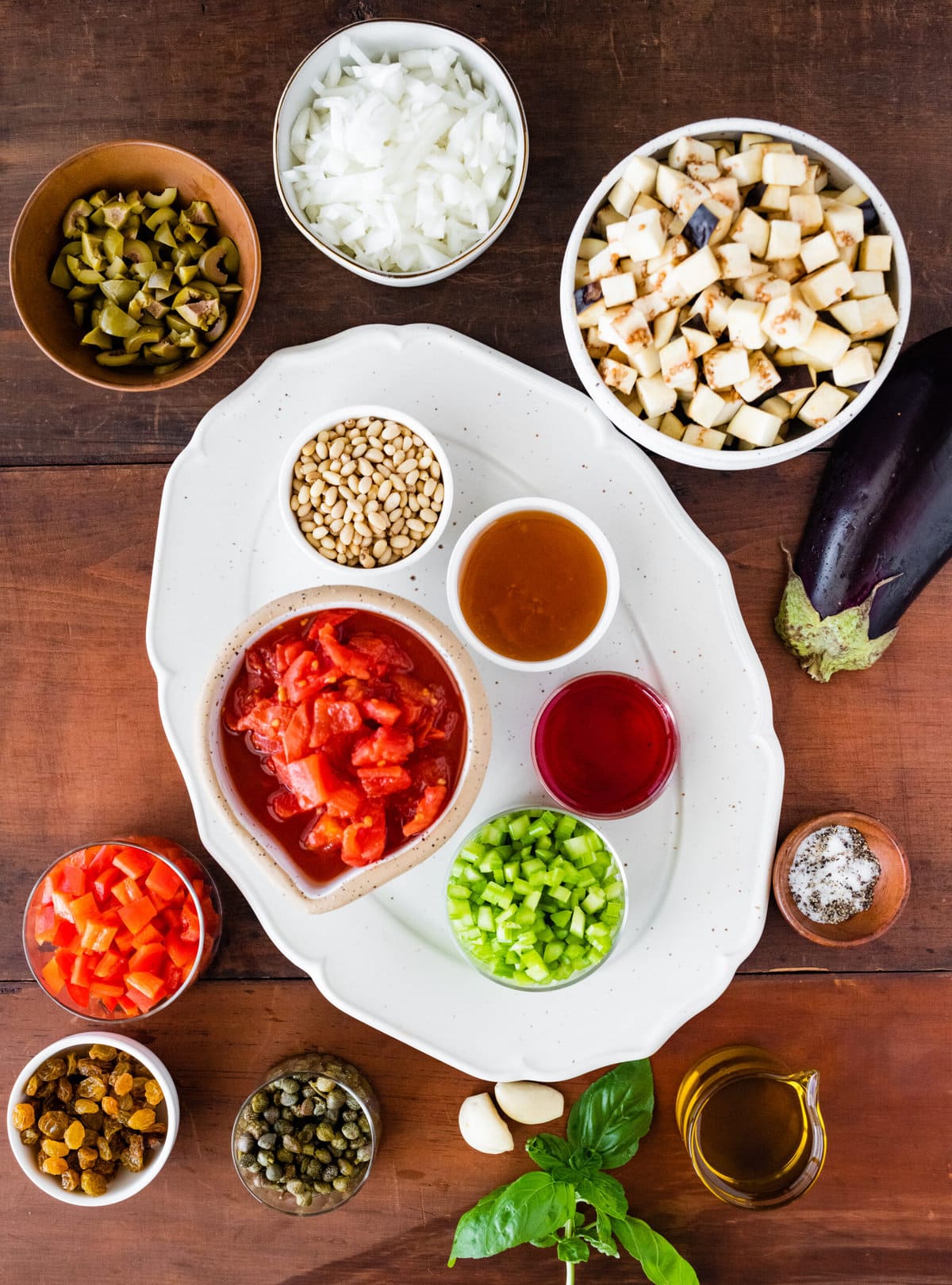
- Eggplants: Diced into small cubes, eggplants provide a rich and creamy texture to the dish.
- Onion: is traditional and adds flavor and aroma to the caponata.
- Celery: contributes a fresh and slightly crunchy element to the dish.
- Red Bell Peppers: Stemmed, seeded, and diced red bell pepper adds color, sweetness, and a mild pepper flavor.
- Green Olives: Pitted and chopped green olives give the caponata a tangy taste.
- Capers: provide a burst of salty and slightly sour flavor.
- Diced Tomatoes: Canned diced tomatoes, preferably San Marzano, form the base of the sauce and offer a rich tomato flavor. You can also use a pound of fresh tomatoes (peeled, seeds removed and diced) if you prefer.
- Red Wine Vinegar: Adds acidity and depth of flavor to the caponata.
- Sugar: Balances acidity and enhances the overall flavor profile.
- Golden Raisins: These sweet raisins add a touch of sweetness to contrast the savory ingredients.
- Toasted Pine Nuts: Provide a pleasant crunch and nutty flavor to the dish.
- Extra-Virgin Olive Oil: Used for sautéing and flavor, olive oil is a staple in Italian cuisine.
- Salt and Pepper: Seasonings that enhance the taste of the ingredients.
- Fresh Basil Leaves: Torn basil leaves are used as a fragrant garnish.
See the recipe card for quantities.
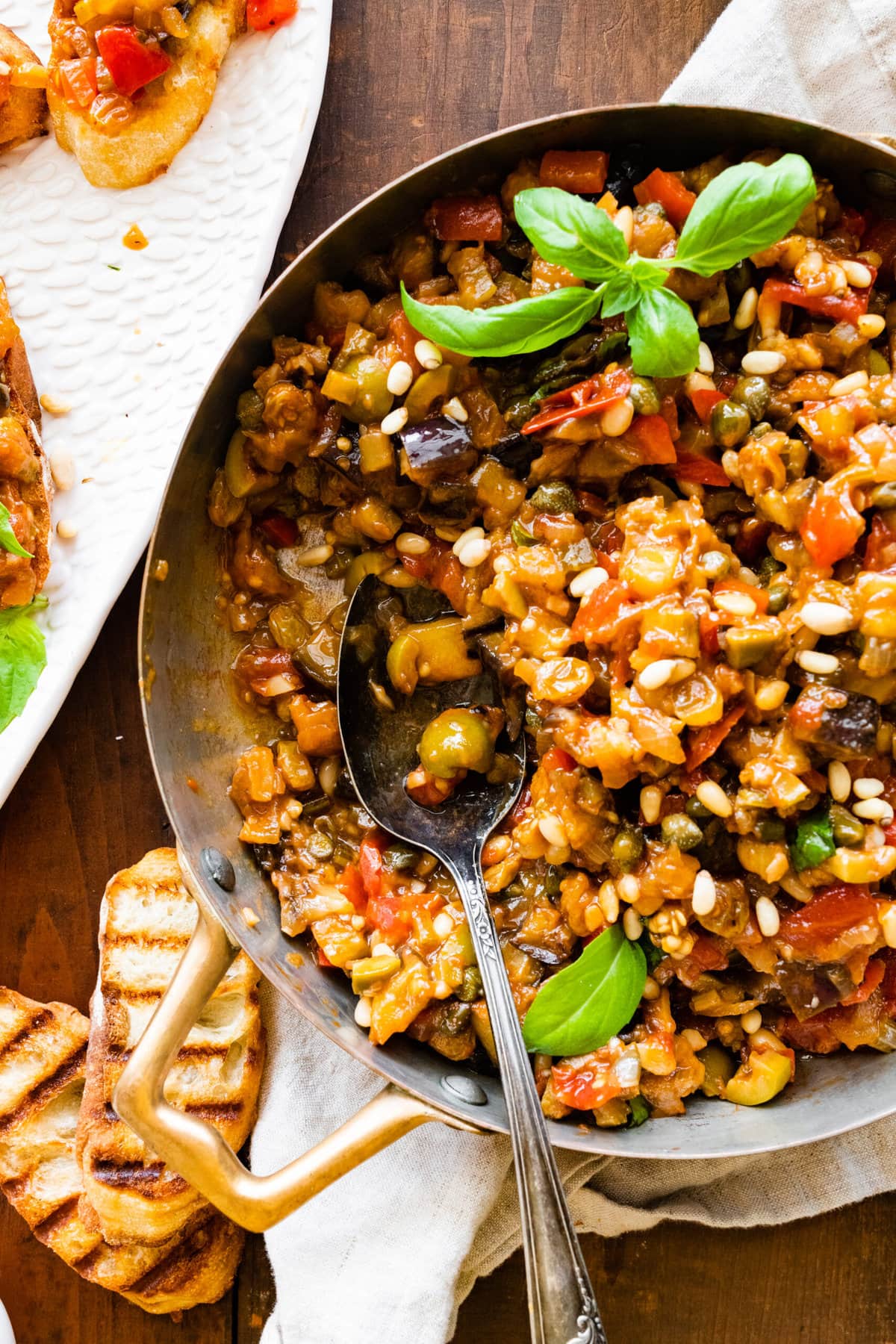
How to Make Sicilian Eggplant Caponata (Step-by-Step Photos)

Prepare the Eggplant: Place the diced eggplant in a colander, sprinkle with salt, and let it sit for about 30 minutes. This helps to remove excess moisture and bitterness from the eggplant. After 30 minutes, rinse the eggplant thoroughly and pat it dry with paper towels.
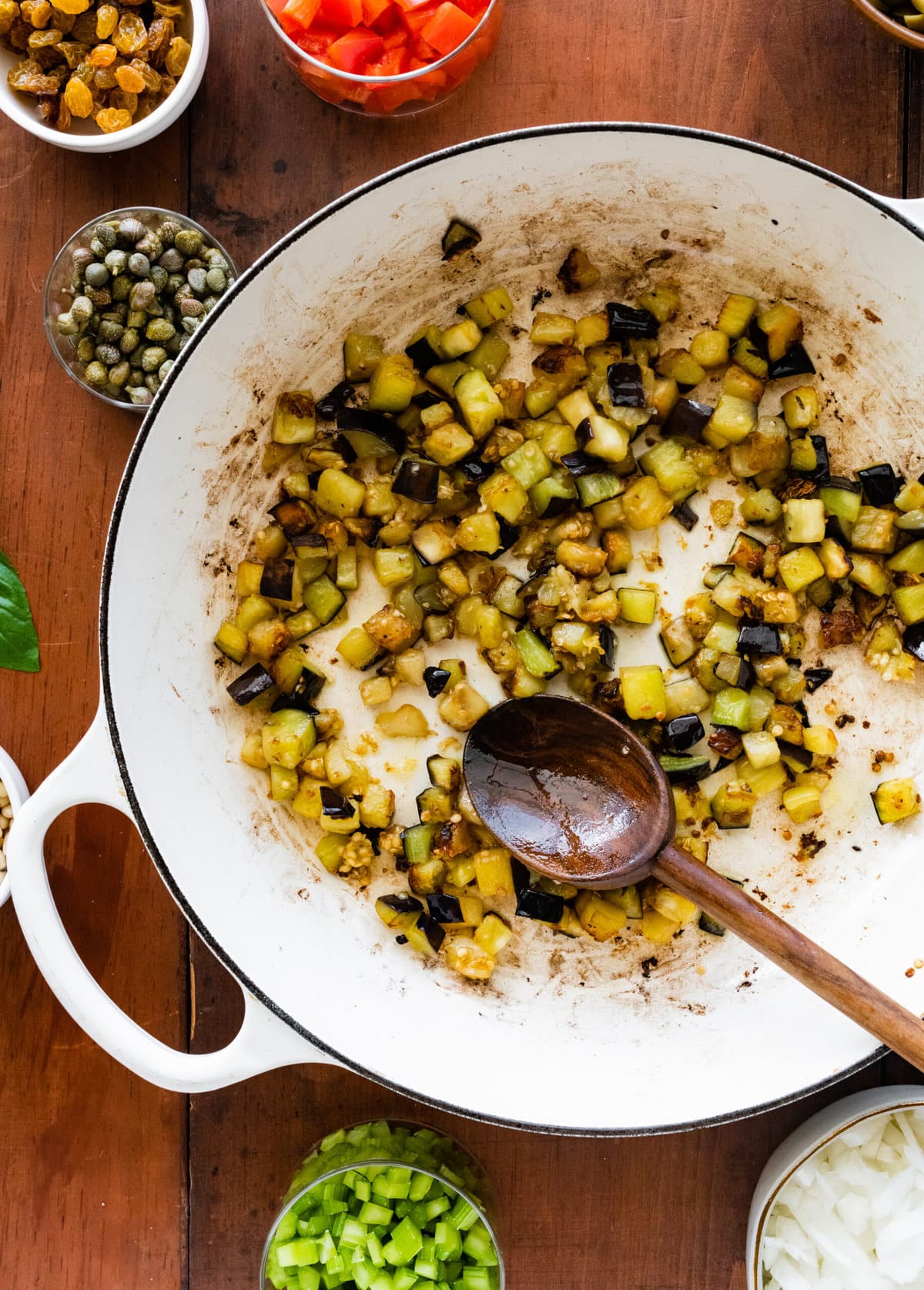
Sauté the Eggplant: In a large skillet, heat about 2 tablespoons of olive oil over medium heat. Add the diced eggplant and sauté until they are golden brown and tender. This might need to be done in batches to avoid overcrowding the pan. Once cooked, remove the eggplant from the skillet and set it aside.
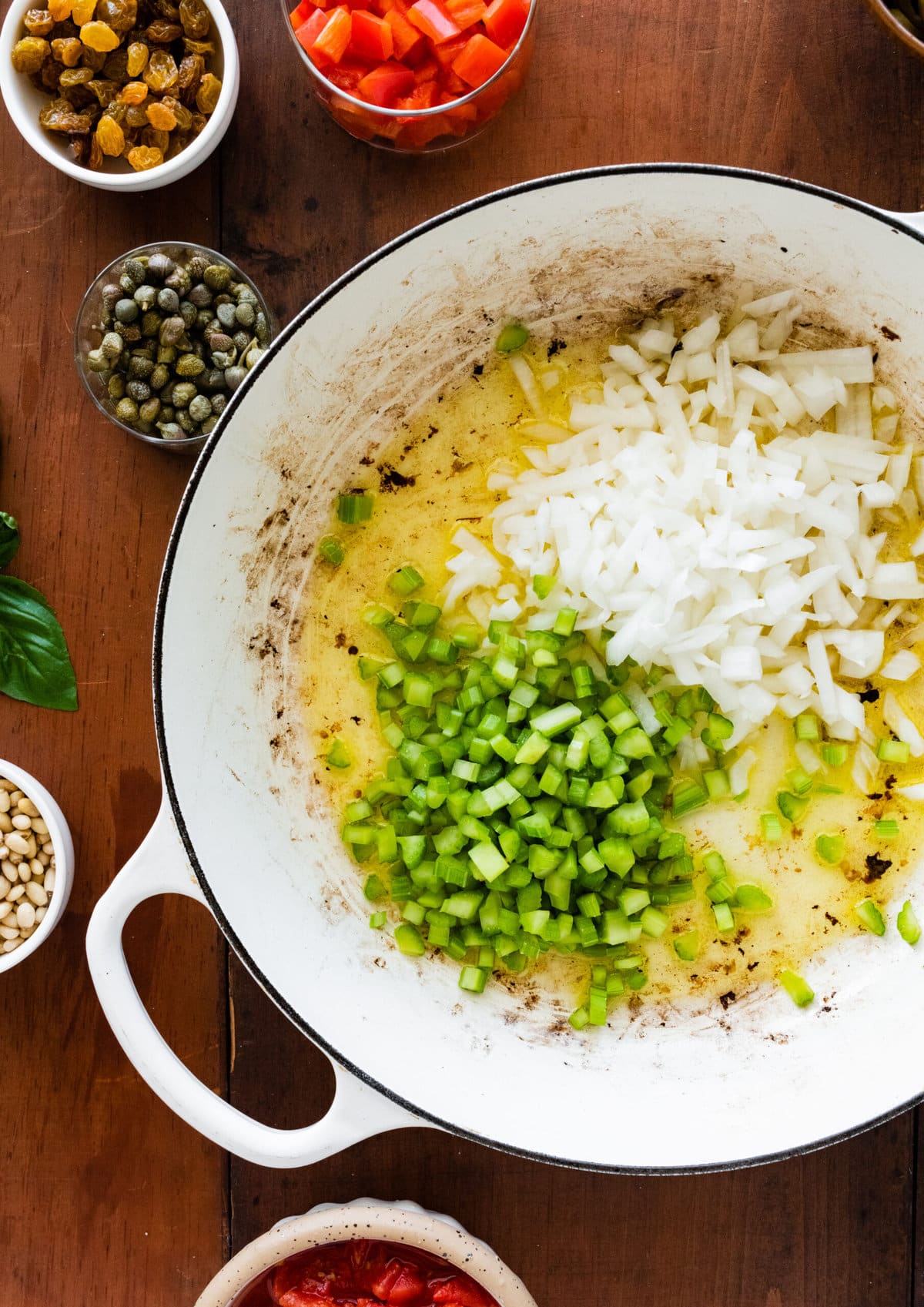
Prepare the Sauce: In the same skillet, add another tablespoon of olive oil if needed. Add the chopped onion and celery. Sauté until they are softened and slightly translucent. Add the garlic and cook for another minute.

Add Tomatoes and Flavorings: Add the can of diced tomatoes (with their juice) to the skillet. Stir in the green olives, capers, sugar, golden raisins, diced red bell pepper, and red wine vinegar. Allow the mixture to simmer over medium-low heat for about 10-15 minutes, stirring occasionally.
Combine Eggplant and Sauce: Add the sautéed eggplant to the skillet with the sauce. Mix everything together and let it simmer for 25-30 minutes, allowing the flavors to meld. If the mixture seems too dry, you can add a splash of water.

Finish and Garnish: Remove it from the heat once the caponata is cooked and the flavors have developed. Stir in the toasted pine nuts. Allow the caponata to cool to room temperature.
Serve: Before serving, garnish the caponata with torn fresh basil leaves. Enjoy caponata as a standalone appetizer, a topping for crostini (small crust toasted bread slices), or a side dish with grilled meats or fish.
Substitutions
Green Olives: If green olives are unavailable, Kalamata olives can be used. They have a deeper flavor and are often associated with Mediterranean cuisine.
Capers: If you’re not a fan of capers or don’t have them on hand, you can omit them or replace them with chopped pickles for a similar tangy element.
Golden Raisins: Dried currants or chopped dried apricots can replace golden raisins to provide a touch of sweetness.
Pine Nuts: Slivered almonds or chopped walnuts can be used instead of pine nuts for a different nutty crunch.
Red Wine Vinegar: White wine vinegar, sherry vinegar, or balsamic vinegar can be used as substitutes for red wine vinegar, though they may impart slightly different flavors.
Fresh Basil: If fresh basil isn’t available, you can use fresh parsley or oregano for a different herbaceous note.
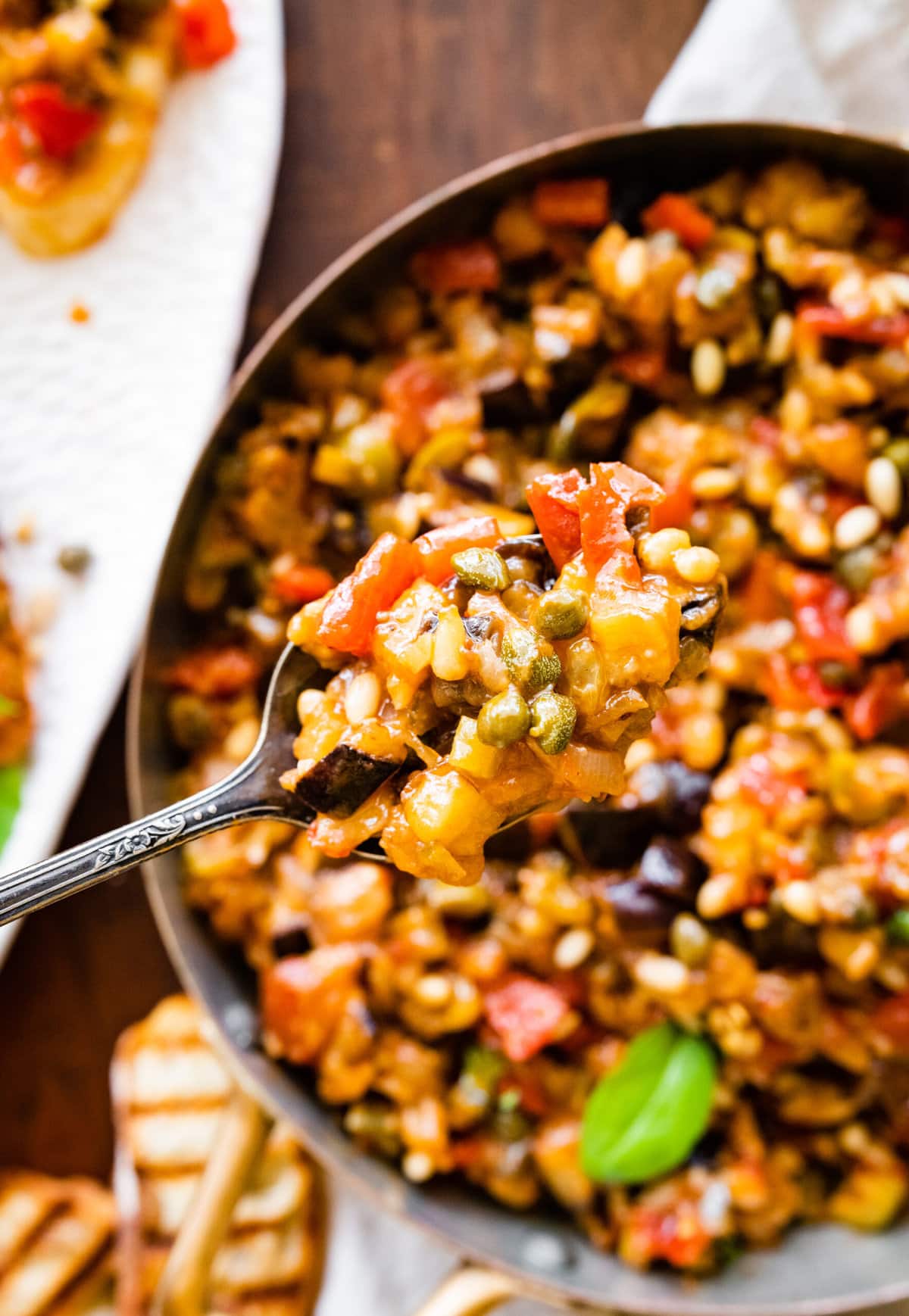
Variations
Here are 5 different versions of the eggplant caponata recipe. Next time, you can try one of these twists.
1. Mediterranean Caponata with Feta: Add crumbled feta cheese to the caponata just before serving for a creamy and tangy contrast to the savory flavors.
2. Spicy Caponata: Incorporate red pepper flakes or finely chopped chili peppers to add a kick of heat to the dish, balancing the sweetness of the other ingredients.
3. Mediterranean Caponata with Artichokes: Include chopped marinated artichoke hearts for an extra layer of flavor and texture.
4. Citrus-Infused Caponata: Add the zest and juice of a lemon or orange to the sauce for a refreshing citrus twist that complements the other flavors.
5. Caponata with Toasted Almonds: Replace pine nuts with toasted almonds for a nutty flavor and crunch variation.

How to Serve Caponata
Serve it as a luscious topping for toasted crostini to create a delicious appetizer.
Elevate your antipasto platter by featuring caponata alongside cheeses, cured meats, and marinated vegetables.
It also shines as a side dish, complementing grilled meats or fish with its sweet and savory flavors.
Transform pasta into a culinary masterpiece by tossing it with warmed caponata. Caponata adds a touch of authentic Italian flair to your dining experience, whether as a dip, topping, or accompaniment.

How to Store
Properly stored in an airtight container, homemade caponata can last 3-4 days in the refrigerator.
Top tips
- Salting Eggplant: Salting and rinsing the diced eggplant helps reduce bitterness and excess moisture. Pat dry before sautéing.
- Golden Raisins: Add a touch of sweetness with golden raisins for a balanced flavor profile.
- Simmering Sauce: Allow the tomato-based sauce to simmer, letting flavors meld for a more delicious outcome.
- Make Ahead: Caponata tastes even better the next day, so prepare for enhanced flavors.
- Serving Temperature: Serve at room temperature, cold, or slightly warm for the best taste experience.
- Vegetable Options: Feel free to customize by adding bell peppers or other veggies you enjoy.

FAQs
Caponata is a traditional Sicilian dish consisting of cooked vegetables, often including eggplant, tomatoes, and various other ingredients. It’s known for its sweet and sour flavors and is usually served as an appetizer or side dish.
Yes, caponata’s flavors tend to improve with time. You can make it a day in advance and store it in the refrigerator. Just bring it to room temperature or gently warm it before serving.
Caponata is a Sicilian dish with eggplant, tomatoes, olives, and capers, known for its sweet and sour taste. From Provence, France, Ratatouille features eggplant, zucchini, and bell peppers, cooked with herbs for a distinct Mediterranean flavor. Both are vegetable dishes with unique ingredients and origins. You can consider caponata a sweet and sour Sicilian version of ratatouille.
Smaller varieties of eggplant, such as Italian or Asian eggplants, work well for caponata as they have fewer seeds and a tender skin. However, larger eggplants can also be used; just be sure to remove any excess seeds.

More Italian Recipes
Looking for other recipes like this? Try these:
What to Serve with Sicilian Eggplant Caponata Recipe
These are my favorite dishes to serve with Eggplant Caponata :
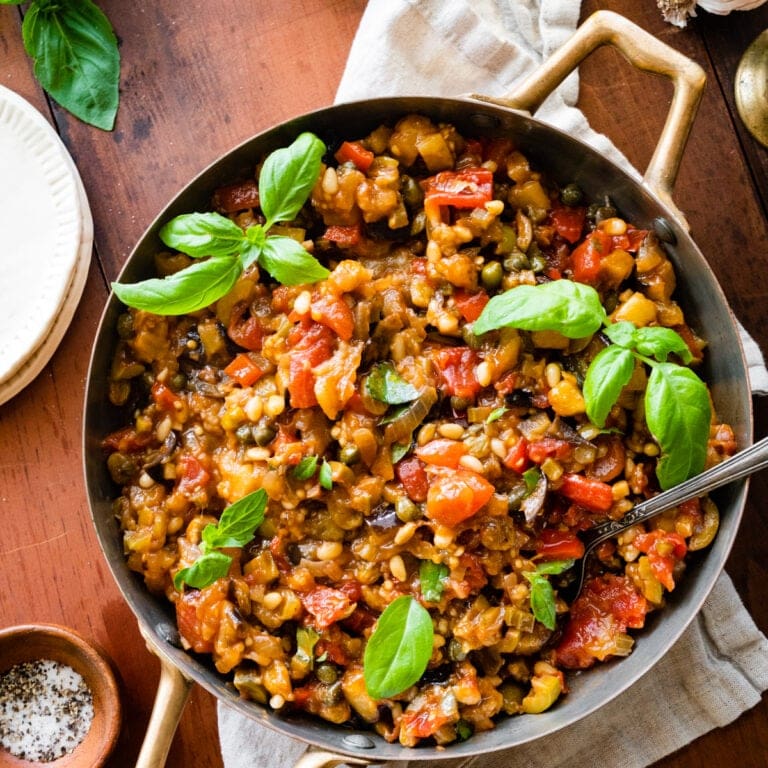
Sicilian Eggplant Caponata Recipe
Sicilian Eggplant Caponata Recipe (Easy)– Bursting with the bold flavors, vegetables, and aromas that define Mediterranean cuisine, this beloved Italian dish is wonderful for any occasion.
- Total Time: 45 minutes
- Yield: 4–6 servings 1x
Ingredients
- 2 large eggplants, diced into small cubes
- 1 medium onion, finely chopped
- 2 garlic cloves, minced
- 2–3 celery stalks, finely chopped
- 1/2 red bell pepper, stemmed, seeded, and diced
- 1/2 cup green olives, pitted and roughly chopped
- 1/4 cup capers, rinsed and drained
- 1 can (14 oz) diced tomatoes in juice (preferably San Marzano)
- 1/4 cup red wine vinegar
- 2 tablespoons sugar or honey
- 3 tablespoons golden raisins
- 1/4 cup toasted pine nuts
- 3–4 tablespoons olive oil
- Salt and pepper to taste
- Fresh basil leaves, torn, for garnish
Instructions
- Prepare the Eggplant: Place the diced eggplant in a colander, sprinkle with salt, and let it sit for about 30 minutes. This helps to remove excess moisture and bitterness from the eggplant. After 30 minutes, rinse the eggplant thoroughly and pat it dry with paper towels.
- Sauté the Eggplant: In a large skillet, heat about 2 tablespoons of olive oil over medium heat. Add the diced eggplant and sauté until they are golden brown and tender. This might need to be done in batches to avoid overcrowding the pan. Once cooked, remove the eggplant from the skillet and set it aside.
- Prepare the Sauce: In the same skillet, add another tablespoon of olive oil if needed. Add the chopped onion and celery. Sauté until they are softened and slightly translucent. Add the garlic and cook for another minute.
- Add Tomatoes and Flavorings: Add the can of diced tomatoes (with their juice) to the skillet. Stir in the green olives, capers, sugar, golden raisins, diced red bell pepper, and red wine vinegar. Allow the mixture to simmer over medium-low heat for about 10-15 minutes, stirring occasionally.
- Combine Eggplant and Sauce: Add the sautéed eggplant to the skillet with the sauce. Gently mix everything together and let it simmer for an additional 25-30 minutes, allowing the flavors to meld. If the mixture seems too dry, you can add a splash of water.
- Adjust Seasoning: Taste and season the caponata with salt and pepper according to your preference. Remember that the olives and capers are already salty, so be cautious with the additional salt.
- Finish and Garnish: Once the caponata is cooked and the flavors have developed, remove it from the heat. Stir in the toasted pine nuts. Allow the caponata to cool to room temperature.
- Serve: Before serving, garnish the caponata with torn fresh basil leaves. Enjoy caponata as a standalone appetizer, a topping for crostini (small crust toasted bread slices), or a side dish with grilled meats or fish.
Storage: Caponata tastes even better when allowed to sit for a few hours or overnight, giving the flavors time to meld. Store any leftovers in an airtight container in the refrigerator.
- Prep Time: 15 min
- Cook Time: 30-35 minutes
- Category: Savory
- Method: Italian
- Cuisine: Italian



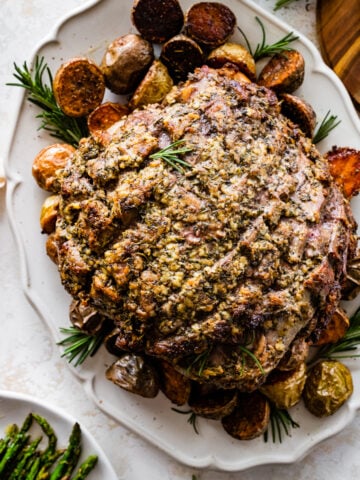


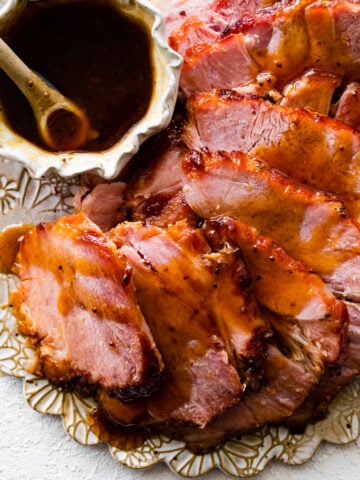


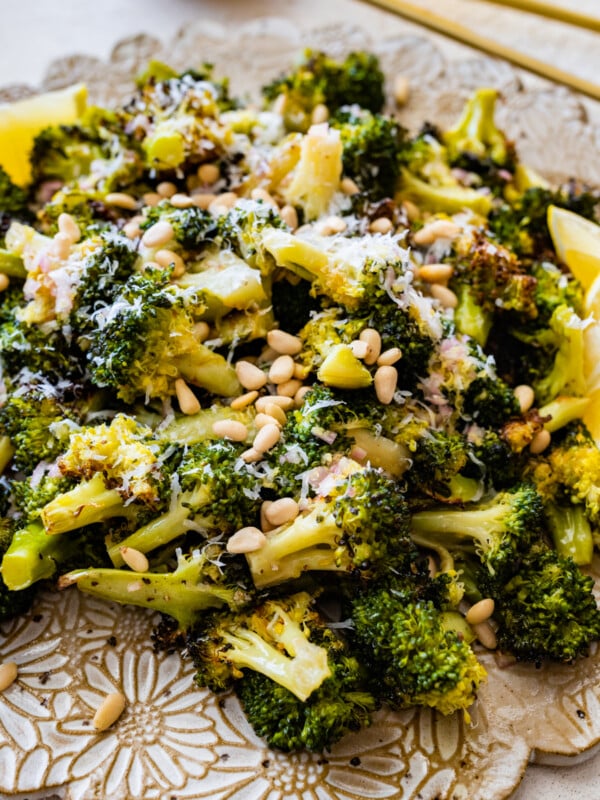






Served it as an appetizer with crostini and everyone loved it!
Authentic and delicious! Perfect for end of summer produce.
Such a great recipe! My whole family loved it. We put it over baked chicken and it was delicious.
I love the way you served it. Sounds delicious! We usually serve as an appetizer.